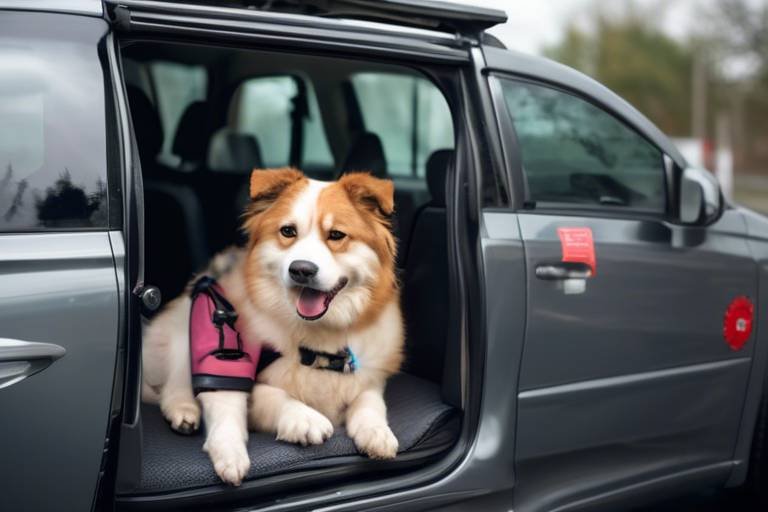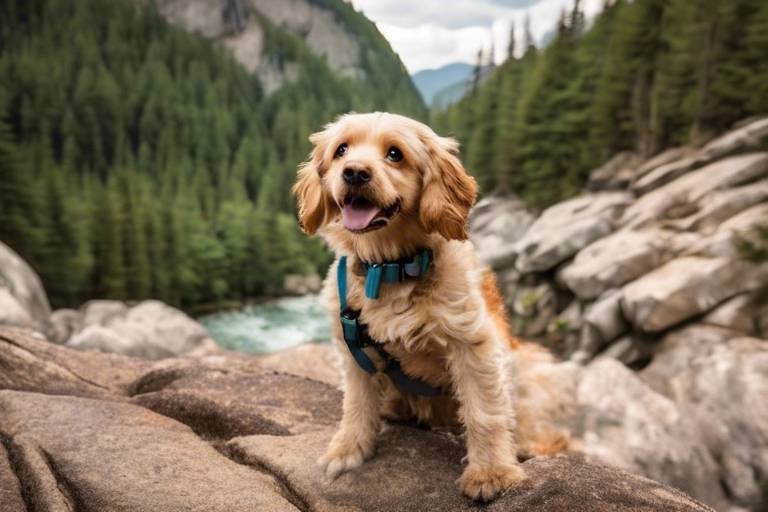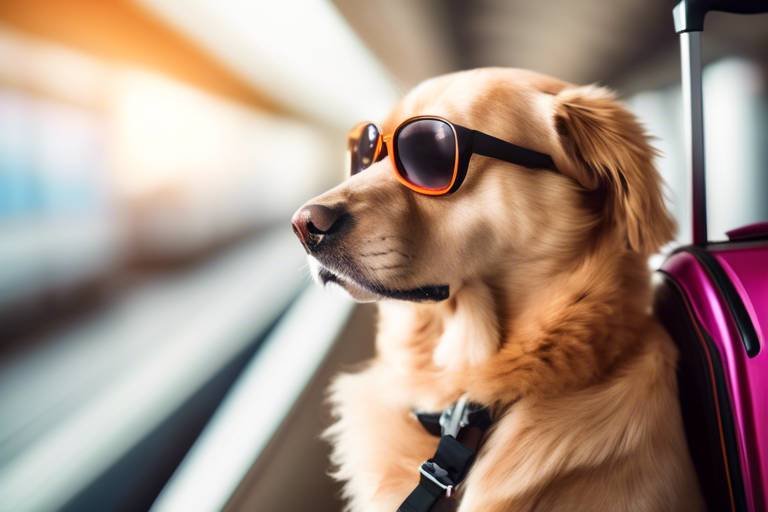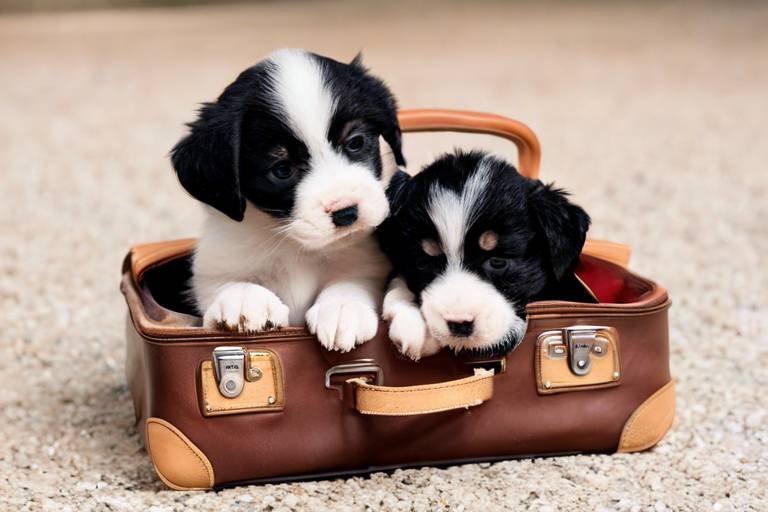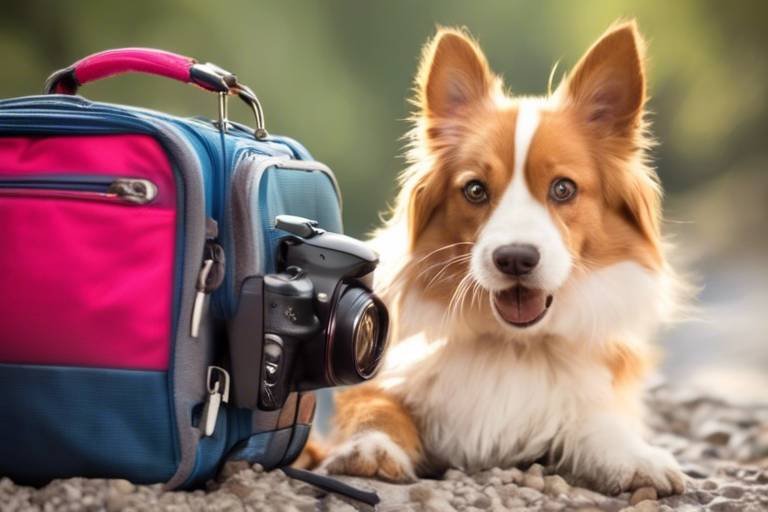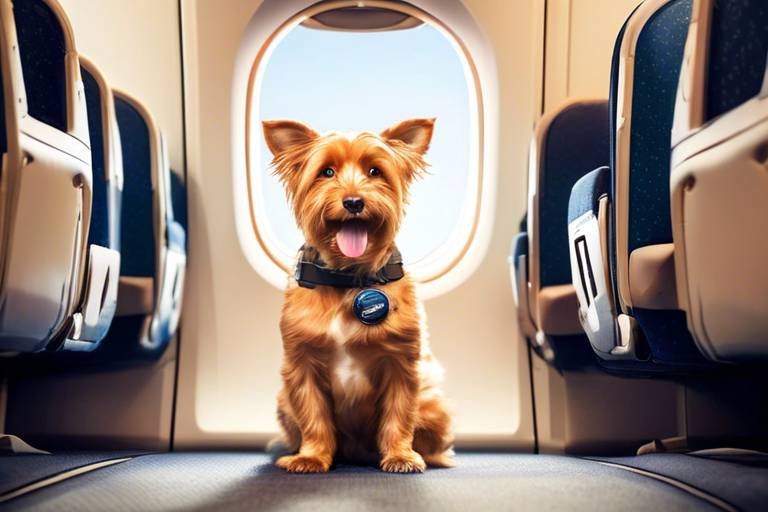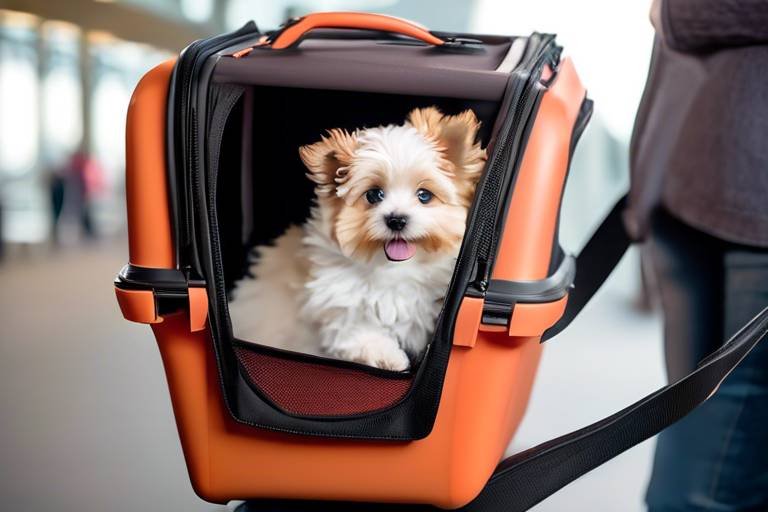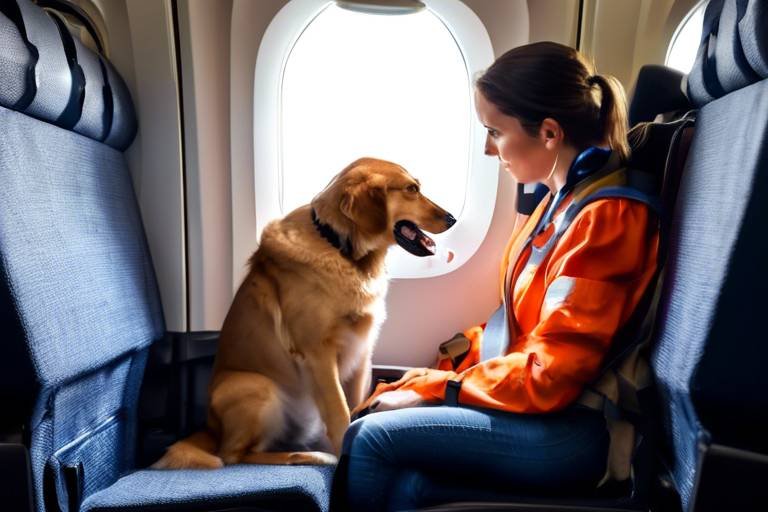Tips for Safe Pet Transportation During Emergencies
In times of crisis, ensuring the safety of your furry companions is paramount. Emergencies can strike unexpectedly, whether it's a natural disaster, a fire, or any other urgent situation. The key to effective pet transportation during these times lies in preparation, awareness, and the right resources. By planning ahead and knowing what to do, you can navigate these challenging situations with confidence, keeping your pets calm and secure.
First and foremost, understanding emergency preparedness is crucial. This means not only having a plan for yourself but also for your pets. Imagine being in the midst of chaos and realizing you haven’t thought about your pet's needs. That's a scenario we want to avoid! By anticipating possible emergencies and having a strategy in place, you can significantly reduce anxiety—for both you and your pets. Start by identifying potential risks in your area and formulating a plan that includes your pets. This plan should involve knowing where to go, how to get there, and what supplies you’ll need.
Speaking of supplies, assembling an emergency pet kit is an absolute must. This kit should contain essential items such as food, water, medications, and comfort items like toys or blankets. Don't forget to include your pet’s identification, such as tags and microchip information. Having these supplies on hand can make a world of difference in ensuring your pet's comfort and safety during transport. You wouldn't leave home without your essentials, right? The same goes for your pets!
Now, let’s dive into the nitty-gritty of transportation. When it comes to choosing the right carrier, it’s vital to consider your pet's size and comfort. A snug fit can help your pet feel secure, but too tight can lead to stress. Think of it like wearing a pair of shoes that are too small—uncomfortable and stressful! Look for carriers that allow enough space for your pet to stand, turn around, and lie down comfortably. Always check the safety features of the carrier, such as secure latches and proper ventilation. This ensures your pet's well-being during the journey.
Getting your pet accustomed to their carrier and the travel process can significantly ease their anxiety. Start by allowing your pet to explore the carrier in a stress-free environment. Place treats or favorite toys inside to create positive associations. Remember, patience is key! It’s like teaching a child to ride a bike; they need time to get comfortable before they can ride confidently.
Transportation methods can vary depending on the emergency. Whether you’re traveling by car or using public transport, safety is paramount. If you’re driving, make sure your pet is secured in their carrier or with a pet seatbelt. This not only keeps them safe but also minimizes distractions for you as the driver. When using public transportation, familiarize yourself with the rules regarding pets. Some buses and trains have specific guidelines, and being prepared can help avoid any last-minute surprises.
In the event that you need to find temporary shelter for your pets, it’s essential to know where to go. Not all emergency shelters accept pets, so doing your research ahead of time can save you a lot of stress. Look for local resources that specialize in pet-friendly accommodations. Websites and local organizations often provide lists of pet-friendly hotels and shelters. Remember, just like you wouldn’t want to be left out in the cold, your pets deserve a safe and warm place too!
After the dust settles from an emergency, it’s crucial to assess your pet’s health. Check for any injuries or signs of stress, and don’t hesitate to seek veterinary care if something seems off. Your pet might need some extra love and attention to help them bounce back. Think of it as a warm hug after a long day—everyone needs a little comfort sometimes!
Finally, re-establishing routines can help your pet regain a sense of normalcy after an emergency. Dogs and cats thrive on routine, and getting back to familiar feeding, walking, and playtime schedules can be incredibly comforting. It’s like returning to your favorite coffee shop after a long trip; it just feels right!
- What should I include in my emergency pet kit? Essential items include food, water, medications, a first-aid kit, identification, and comfort items like toys.
- How can I prepare my pet for travel during an emergency? Acclimate your pet to their carrier by letting them explore it and rewarding them with treats.
- Are there pet-friendly emergency shelters? Yes, but not all shelters accept pets. Research local resources beforehand to find suitable options.
- What should I do if my pet gets injured during an emergency? Assess their health immediately and seek veterinary care if necessary.

Understanding Emergency Preparedness
Emergency preparedness for pets is not just a buzzword; it’s a lifeline. Imagine the chaos of a sudden disaster—whether it’s a natural calamity like a hurricane or an unexpected fire. In such moments, having a plan in place can mean the difference between safety and panic. By preparing ahead of time, you can ensure that your furry friends remain secure and calm, even when the world around you is in turmoil.
First and foremost, understanding the types of emergencies that might arise in your area is crucial. Are you living in a region prone to floods, earthquakes, or wildfires? Each scenario requires a tailored approach to keep your pets safe. For instance, if you live in a flood-prone area, it’s wise to have an elevated pet carrier ready, while those in wildfire zones might need to consider air quality and evacuation routes.
Moreover, it’s essential to have a comprehensive emergency plan that includes your pets. This plan should detail:
- Where to go in case of evacuation
- How to transport your pets safely
- What supplies to take with you
- Emergency contact numbers, including your veterinarian's
Another critical aspect of emergency preparedness is creating a pet-friendly emergency kit. This kit should be easily accessible and contain items such as food, water, medications, and comfort items like a favorite toy or blanket. By having these essentials on hand, you can reduce stress for both you and your pet during a crisis. Remember, pets can sense anxiety, so a calm demeanor from you can help keep them at ease.
Finally, practice makes perfect! Regularly review and update your emergency plan and supplies. Involve your pets in the process by getting them used to their carriers and the idea of travel. Just like us, pets can feel more secure when they know what to expect. So, take the time to familiarize them with their emergency kit and practice your evacuation routes. This proactive approach not only prepares you for the worst but also strengthens the bond you share with your pets.

Essential Supplies for Pet Transportation
When it comes to transporting your furry friends during emergencies, having the right supplies on hand is not just important; it's essential. Think of your pet's transportation kit as a lifeline that ensures their comfort and safety when chaos strikes. Imagine being in a high-stress situation where every second counts—having a well-prepared kit can make a world of difference. So, what should you include in this all-important kit? Let’s dive into the essentials!
First and foremost, a sturdy and comfortable pet carrier is non-negotiable. This is where your pet will spend most of their time during transport, so it must be appropriate for their size and needs. Along with the carrier, ensure you have a leash and collar that are secure and fit well. This can be crucial for quick exits and entries, especially in crowded or unfamiliar places.
Next, consider packing some food and water. It's easy to overlook, but your pet's dietary needs shouldn’t be ignored, even in emergencies. Bring enough food for at least a few days, along with portable water bowls. You might also want to include a few treats to keep their spirits up during the journey. Remember, a happy pet is a calm pet!
Another vital item is a first aid kit specifically designed for pets. This should include basic medical supplies such as bandages, antiseptic wipes, and any medications your pet may need. You can either purchase a pre-made kit or assemble one yourself. Just think of it as a mini-emergency room on the go!
Finally, don’t forget to pack your pet's favorite blanket or toy. Familiar scents and textures can provide comfort and help ease anxiety during stressful situations. These little touches can make a big difference in how your pet copes with the journey.
| Essential Supplies | Purpose |
|---|---|
| Pet Carrier | Provides a safe and secure space for your pet. |
| Leash and Collar | Ensures your pet can be safely handled. |
| Food and Water | Keeps your pet nourished and hydrated. |
| First Aid Kit | Addresses minor injuries and health issues. |
| Blanket or Toy | Offers comfort and familiarity during transport. |
In summary, preparing a comprehensive emergency pet transportation kit is crucial for your pet's safety and well-being. By gathering these essential supplies, you can ensure that your furry friend is comfortable, secure, and ready to face whatever challenges come your way. Remember, a little preparation can go a long way in making a stressful situation much more manageable.
- What should I include in my pet's emergency kit? Your kit should have a pet carrier, leash, food, water, first aid supplies, and familiar items like a blanket or toy.
- How can I help my pet feel more comfortable during transport? Use familiar items, keep a calm demeanor, and provide breaks if possible.
- Are there specific carriers recommended for emergencies? Look for carriers that are sturdy, well-ventilated, and have secure latches.
Choosing the Right Carrier
When it comes to transporting your furry friends during emergencies, selecting the right carrier is absolutely crucial. Think of it as choosing a safety net for your pet—one that will keep them secure and comfortable while you're on the move. The right carrier not only ensures your pet's safety but also reduces their anxiety during stressful situations. So, how do you choose the best carrier for your beloved companion? Let's dive into the essential factors to consider!
First and foremost, you need to assess the type of carrier that best suits your pet's needs. There are various styles available: soft-sided carriers, hard-sided carriers, and even backpacks designed for pets. Each has its own advantages and disadvantages. For instance, soft-sided carriers are often lighter and easier to store, making them perfect for smaller pets and short trips. On the other hand, hard-sided carriers provide more protection and are often required for air travel. It's essential to weigh these options based on your travel plans and your pet's temperament.
Next, size matters! Ensuring that your pet has enough space to stand, turn around, and lie down comfortably is vital. A cramped environment can lead to stress and discomfort, which is the last thing you want during an emergency. To help you gauge the right size, consider measuring your pet from nose to tail and from the ground to the top of their head when they are standing. This will give you a clear idea of the minimum dimensions you need for the carrier. Ideally, you want to choose a carrier that is just a bit larger than your pet's measurements, allowing them to move around freely.
Another important aspect to consider is the carrier's safety features. Look for options that come with secure latches and sturdy construction. You wouldn't want your pet to accidentally escape during a chaotic moment, right? Additionally, good ventilation is crucial. Carriers should have adequate airflow to keep your pet comfortable, especially if you're traveling for an extended period. Some carriers even come with removable, washable liners to maintain hygiene, which is a huge plus!
Lastly, it's a good idea to familiarize your pet with the carrier before an emergency arises. This can be done by leaving the carrier open at home and encouraging your pet to explore it. You can place their favorite toys or treats inside to create positive associations. The more comfortable your pet is with their carrier, the less stressed they will be when it's time to travel. Remember, a little preparation goes a long way!
In summary, choosing the right carrier involves considering your pet's size, comfort, safety features, and their familiarity with the carrier. With the right choice, you can ensure a smoother, safer transportation experience for your furry friend during emergencies.
Size and Comfort Considerations
When it comes to transporting your furry companions, size and comfort are paramount. Imagine being crammed into a tiny space during a stressful situation; it’s not just uncomfortable, but it can also heighten anxiety. Therefore, choosing the right carrier is not merely about fitting your pet inside; it’s about ensuring they have enough room to move around a bit and feel secure. A carrier that is too small can make your pet feel trapped, while one that is too large might not provide the sense of security they need.
To determine the right size, measure your pet from the tip of their nose to the base of their tail and from the ground to the top of their head while they’re standing. This will give you a baseline to find a carrier that allows them to sit, stand, and turn around comfortably. For example, if you have a small dog or a cat, a carrier that is at least a few inches longer and taller than their measurements will provide the necessary space for comfort.
Moreover, consider the material of the carrier as well. Soft-sided carriers can be more comfortable for pets, especially if they are used to being in cozy spaces. They can also provide a sense of security, as the soft walls can feel less intimidating than rigid ones. However, if your pet is prone to chewing or scratching, a sturdy hard-sided carrier might be the better choice. Ultimately, the goal is to create an environment where your pet feels safe and relaxed during transport.
Additionally, think about the temperature inside the carrier. A well-ventilated carrier is essential to keep your pet from overheating, especially during warm weather. Look for carriers with mesh panels to allow airflow. You can also place a familiar blanket or toy inside to make the space feel more like home. This can significantly reduce anxiety and help your pet feel more at ease during the journey.
In summary, when selecting a carrier, keep in mind the following factors:
- Size: Ensure your pet can stand, turn, and lie down comfortably.
- Material: Choose between soft-sided and hard-sided based on your pet’s behavior and comfort needs.
- Ventilation: Look for carriers with adequate airflow to prevent overheating.
- Familiar Items: Include a blanket or toy to help soothe your pet during the trip.
By taking these considerations into account, you can ensure that your pet travels safely and comfortably, making the entire experience less stressful for both of you!
Carrier Safety Features
When it comes to transporting your beloved pets, ensuring their safety during transit is paramount. One of the most critical aspects of safe pet transportation is the selection of a carrier that incorporates essential safety features. A well-designed carrier can make all the difference, providing not only a secure environment for your pet but also peace of mind for you as a pet owner.
First and foremost, look for carriers with secure latches. These latches should be robust and easy to operate, preventing any accidental openings during travel. Imagine driving down the road and suddenly realizing that your pet could escape—it's a nightmare scenario that can be easily avoided with a reliable latch system. Additionally, a carrier with a locking mechanism can offer an extra layer of security, especially in crowded public spaces or during emergencies.
Another crucial feature to consider is ventilation. Proper airflow is essential for your pet's comfort, especially during longer journeys. Carriers should have adequate ventilation holes or mesh panels that allow for air circulation. This helps prevent overheating and ensures that your furry friend stays calm and comfortable throughout the ride. After all, nobody wants a stressed-out pet panting in a stuffy carrier!
Furthermore, you should also assess the sturdiness of the carrier. A strong, durable construction will protect your pet from potential hazards during transport. Look for carriers made from materials that can withstand bumps and jolts. A flimsy carrier can lead to accidents or, worse, injuries to your pet. Think of it as a protective shell—your pet deserves a fortress that keeps them safe while on the move!
Lastly, consider carriers that offer easy access for both you and your pet. Carriers with multiple entry points can make it easier to load and unload your pet, especially in stressful situations. This feature is particularly beneficial if you have a larger pet or if your pet is anxious about being confined. The easier it is to get them in and out, the less stressful the experience will be for everyone involved.
In summary, when choosing a carrier, prioritize safety features such as secure latches, proper ventilation, sturdiness, and easy access. These elements not only enhance your pet's safety during travel but also contribute to a more pleasant journey for both you and your furry companion. Remember, a little preparation goes a long way in ensuring a smooth and secure transportation experience!
- What should I look for in a pet carrier? Look for secure latches, proper ventilation, sturdy construction, and easy access points.
- Can I use my pet's carrier for air travel? Yes, but ensure it meets the airline's specific requirements for pet carriers.
- How do I acclimate my pet to their carrier? Gradually introduce your pet to the carrier by allowing them to explore it at home and rewarding them with treats.
- Is it safe to transport my pet in the back of a truck? No, it's not safe. Always transport pets in a secure, enclosed space.
Preparing Your Pet for Travel
Traveling with your furry friend can be a delightful experience, but it can also be a source of anxiety for both you and your pet. To make the journey smoother, it's essential to prepare your pet for travel well in advance. This preparation is akin to training for a marathon; the more you practice, the easier it becomes! Start by introducing your pet to their carrier or travel crate. Allow them to explore it at their own pace. You can place their favorite blanket or a toy inside to make it feel more like home. The goal here is to create a positive association with the carrier, so they see it as a safe haven rather than a confinement.
Next, consider taking your pet on short car rides. This gradual exposure can help them get accustomed to the sensation of being in a moving vehicle. Just like humans, pets can feel motion sickness, so it's crucial to monitor how they react. If your pet shows signs of distress, consult your veterinarian for advice on how to manage travel-related anxiety. You might also want to familiarize your pet with the sounds and sensations of the car by taking them for a spin around the block. This is a great way to ease them into the idea of longer journeys.
Another critical aspect of preparing your pet for travel is ensuring they are comfortable. Make sure their carrier is well-ventilated and spacious enough for them to stand, turn around, and lie down comfortably. Remember, just as you wouldn’t want to be cramped in a small space for hours, your pet deserves the same consideration. You can also add a cozy blanket or a familiar item to the carrier to help them feel secure.
Before you hit the road, don’t forget to check that your pet is up-to-date on vaccinations and has identification tags that include your current contact information. In case of an emergency, having this information readily available can be a lifesaver. Additionally, if your pet has any special needs or medications, prepare a travel kit with everything you might need, including food, water, and any necessary medications. You wouldn’t want to be caught off guard without your essentials!
Lastly, consider practicing some commands or tricks before the trip. This can help reinforce positive behaviors and keep your pet calm during the journey. Think of it as a mini training session; rewarding them for good behavior can make a world of difference. Remember, a well-prepared pet is a happy pet, and with the right preparation, your travel experience can be enjoyable for both of you!
- How can I help my pet overcome travel anxiety? Gradual exposure to the carrier and short trips can help. Consult your vet for additional strategies.
- What should I pack for my pet during travel? Essentials include food, water, medications, a leash, waste bags, and comfort items like toys or blankets.
- Is it safe for my pet to travel in the car? Yes, as long as they are secured in a carrier or with a pet seatbelt. Make sure to take breaks for bathroom and exercise.

Identifying Safe Transportation Methods
When emergencies strike, knowing how to transport your beloved pets safely can be a daunting task. Different situations may call for different methods of transportation, and understanding these options is crucial. Whether you're evacuating due to a natural disaster or simply moving to a safer location, making the right choice can ensure your pet's safety and comfort. So, what are the best ways to get your furry friends from point A to point B without causing them undue stress?
First and foremost, it's essential to assess the situation. If you're using a car, make sure to secure your pet properly. This means using a sturdy carrier or a pet seatbelt to prevent them from moving around too much during the drive. Not only does this keep them safe, but it also minimizes distractions for the driver. Remember, a calm pet makes for a calm journey!
In cases where you might need to rely on public transportation, such as buses or trains, familiarize yourself with the specific rules and regulations regarding pets. Many public transport systems have strict guidelines about the size and type of animals allowed on board. For instance, some may require pets to be in carriers, while others might only allow small dogs. Always check in advance to avoid any last-minute surprises that could lead to stress for both you and your pet.
During emergencies, you may also find yourself relying on emergency services for transportation. It's vital to communicate your needs clearly when seeking help. Not all emergency services are equipped to handle pets, so be ready to ask about their policies and procedures. If they cannot assist, they might be able to direct you to local organizations that specialize in pet evacuation.
When deciding on the best transportation method, consider the following factors:
- Distance: Longer distances may require more planning and comfort for your pet.
- Type of Emergency: Different emergencies (like floods vs. wildfires) may necessitate different approaches.
- Pet's Temperament: Some pets handle travel better than others, so tailor your approach to their comfort level.
In summary, identifying the safest transportation methods for your pets during emergencies involves a mix of preparation, understanding your options, and being adaptable to changing situations. By keeping these considerations in mind, you can ensure that your pets remain safe and secure, even in the face of uncertainty.
Q: What should I do if my pet is anxious about traveling?
A: Gradually acclimate your pet to their carrier and short car rides before an emergency. Use treats and positive reinforcement to create a positive association with travel.
Q: Are there specific carriers recommended for travel?
A: Look for carriers that are well-ventilated, secure, and appropriately sized for your pet. Brands like Petmate and Sherpa offer a variety of options that are both safe and comfortable.
Q: Can I take my pet on public transport during an emergency?
A: Yes, but check with your local transit authority for their pet policies. Many places allow pets in carriers, but rules can vary, so it's best to confirm beforehand.
Q: What if I can't find a pet-friendly shelter during an emergency?
A: Research pet-friendly hotels or motels in your area. Websites like BringFido can help you find accommodations that welcome pets.
Car Travel Safety Tips
Traveling by car with your furry companion can be a delightful experience, but it also comes with its own set of challenges. To ensure a safe and enjoyable journey for both you and your pet, there are several key to keep in mind. First and foremost, always secure your pet in a carrier or with a safety harness designed specifically for pets. This not only keeps them safe in case of sudden stops but also prevents distractions while you’re driving. Think of it as putting on a seatbelt; it’s just a smart move!
Another important aspect is to make sure your pet is comfortable during the ride. Bring along their favorite blanket or toy to create a familiar atmosphere. You wouldn’t want to feel out of place in a moving vehicle, right? Additionally, plan for regular breaks every two to three hours. Just like us, pets need to stretch their legs and relieve themselves. During these breaks, keep your pet on a leash to prevent any unexpected escapades.
It’s also essential to keep the car well-ventilated and at a comfortable temperature. Pets can overheat quickly, especially in warm weather, so ensure that the air conditioning is running or the windows are slightly open (but not enough for them to jump out!). If you’re traveling with a small dog or cat, consider using a pet seat cover to protect your seats from fur and accidents. It makes clean-up a breeze!
Finally, never leave your pet alone in a parked car. Even on a mild day, the temperature inside a car can rise to dangerous levels very quickly. If you need to stop somewhere, it’s best to take your pet with you or leave them with someone who can watch them. Remember, your pet relies on you for their safety and well-being, so being proactive is key!
- What should I do if my pet gets car sick? If your pet is prone to motion sickness, consult your veterinarian about possible medications or natural remedies. Gradual acclimatization to car rides can also help.
- Is it safe to let my dog stick its head out the window? While it may seem fun for them, it can be dangerous due to flying debris and the risk of jumping out. It’s best to keep the windows closed or only slightly open.
- How can I keep my pet calm during a long drive? Consider using calming products like pheromone sprays or calming music specifically designed for pets. Frequent breaks and positive reinforcement can also help.
Using Public Transportation with Pets
Traveling with your furry friend on public transportation can be a bit of a puzzle, but with the right knowledge, it can be a smooth ride! First things first, it's essential to understand the rules and regulations of the specific transportation service you'll be using. Different transit systems have different policies regarding pets, and knowing these can save you from last-minute surprises. For instance, some buses or trains might require your pet to be in a carrier, while others may allow them to sit on your lap. It’s always a good idea to check the official website of the transportation service or call ahead to confirm their pet policy.
When preparing for your journey, ensure that your pet is comfortable and familiar with their carrier. If your pet is anxious or restless, consider taking them on shorter trips to get them accustomed to the carrier and the hustle and bustle of public transport. You wouldn’t want your little buddy feeling stressed out before the journey even begins!
Here are a few key tips to keep in mind when using public transportation with pets:
- Keep your pet leashed: Always have your pet on a leash when navigating through stations or waiting areas. This not only keeps them safe but also reassures other passengers.
- Bring essentials: Pack a small bag with essentials like water, a portable bowl, treats, and waste bags. You never know when a little snack or bathroom break might be needed!
- Travel during off-peak hours: If possible, try to travel during less busy times. This can make the experience less stressful for both you and your pet.
Moreover, if your pet is larger or needs more space, consider using a soft-sided carrier that can fit under the seat. This not only keeps them secure but also allows them to feel more at ease. Remember, a calm pet makes for a more enjoyable journey for everyone on board!
Lastly, always be respectful of fellow passengers. Not everyone is a pet lover, so keeping your pet calm and contained can help ensure a pleasant experience for everyone involved. If your pet tends to get vocal or anxious, it might be worth considering some training or calming aids before your trip. After all, a happy pet means a happy trip!
Q: Can I take my pet on public transportation?
A: Yes, but policies vary by transportation service. Always check the specific rules for the service you plan to use.
Q: Do I need a carrier for my pet?
A: Many transit systems require pets to be in carriers, especially if they are small. Larger pets usually need to be leashed and may have specific requirements.
Q: What should I bring for my pet on public transport?
A: Essentials include water, a portable bowl, treats, waste bags, and any comfort items like a blanket or toy.
Q: How can I help my pet feel more comfortable during travel?
A: Familiarize your pet with their carrier beforehand, travel during off-peak hours, and keep them calm with treats and praise.
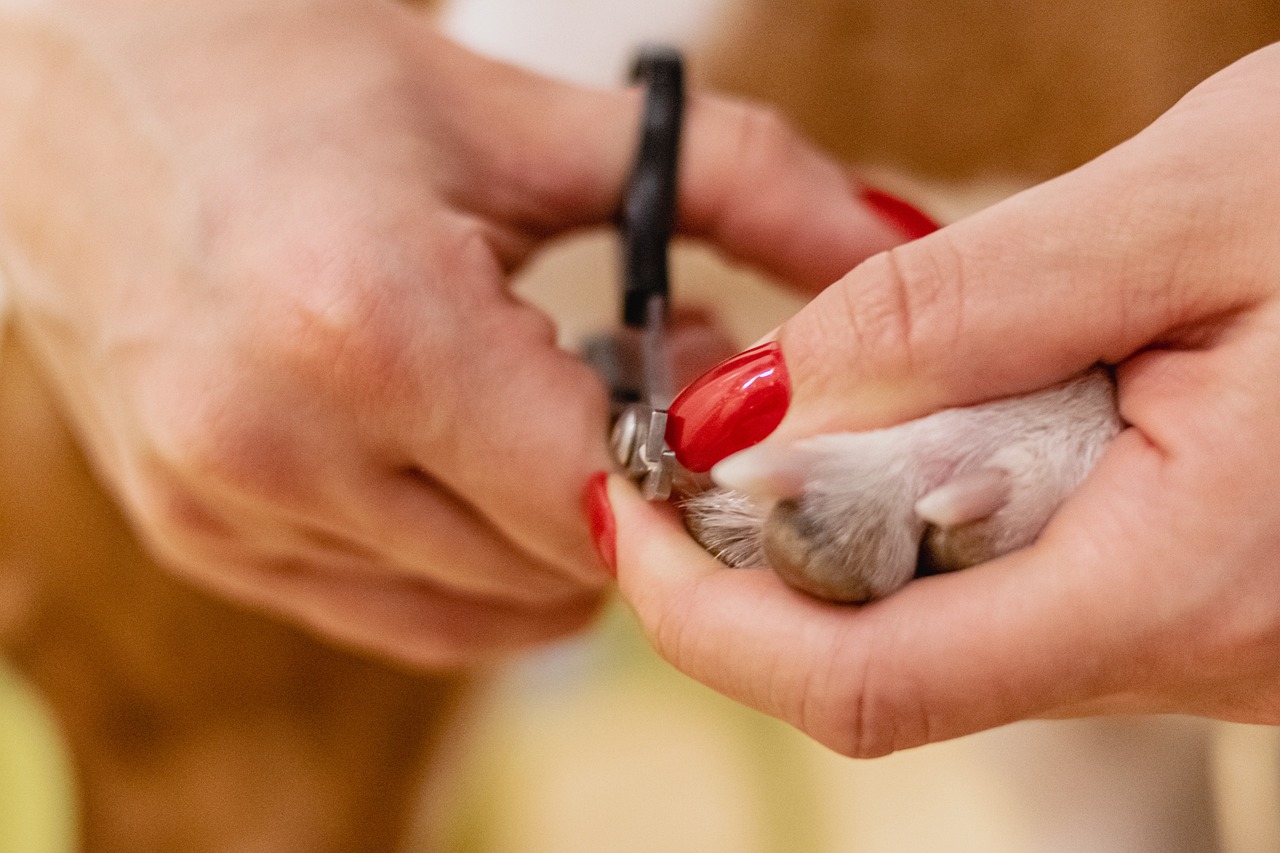
Finding Temporary Shelter for Pets
In times of crisis, securing a temporary shelter for your pets can feel like searching for a needle in a haystack. It’s crucial to be prepared and know where to look when emergencies arise. Many shelters may not accommodate pets, so having a list of resources can save you and your furry friends a lot of stress. Start by checking with local animal shelters, humane societies, or even community centers that may offer temporary housing for pets during disasters.
When looking for temporary shelter, consider these key factors:
- Location: Proximity to your home or the area where the emergency occurred can save valuable time.
- Pet Policies: Always inquire about the shelter's pet policies beforehand to avoid any surprises.
- Facilities: Ensure the shelter can provide the necessary facilities for your pet's comfort and safety.
Here’s a quick overview of potential places to find temporary shelter for your pets:
| Type of Shelter | Considerations |
|---|---|
| Emergency Shelters | Check if they allow pets; many may have specific areas for animals. |
| Pet-Friendly Hotels | Look for hotels that welcome pets, often found on travel websites. |
| Friends or Family | Reach out to loved ones who may have space to accommodate your pets. |
Finding a safe place for your pets during an emergency doesn’t have to be daunting. It’s all about preparation and knowing your options. Before an emergency strikes, compile a list of local resources, including pet-friendly hotels, emergency shelters, and even trusted friends who can help. This way, you can act quickly and effectively, ensuring your pets are safe and secure.
Q1: What should I do if I can't find a shelter that accepts pets?
A1: If you can’t find a shelter that accepts pets, consider reaching out to local animal rescue organizations. They often have resources and may know of temporary accommodations that can help.
Q2: Are there any apps or websites that can help me find pet-friendly shelters?
A2: Yes, several apps and websites are dedicated to helping pet owners locate pet-friendly accommodations during emergencies. Websites like BringFido and PetFriendlyHotels can be useful.
Q3: How can I prepare my pet for a stay in a temporary shelter?
A3: To prepare your pet for a temporary shelter stay, bring familiar items such as their bedding, toys, and food. This will help them feel more comfortable in a new environment.
Emergency Shelters and Pet Policies
When disaster strikes, finding a safe haven for your pets can be a daunting task. Not all emergency shelters are equipped to accommodate our furry friends, which is why it's essential to do your homework ahead of time. Imagine being in a chaotic situation where you have to leave your home, and the last thing you want is to worry about your pet's safety. Knowing which shelters accept pets can alleviate some of that stress.
Start by contacting local emergency management agencies or checking their websites for lists of shelters that allow pets. Many communities have designated emergency shelters that are pet-friendly, but availability can vary greatly depending on the type of disaster and location. It’s also wise to have a plan in place that includes a list of these shelters and their contact information. You never know when you might need it!
Before heading to a shelter, it’s crucial to prepare your pet for the experience. Bring essential supplies such as food, water, medications, and comfort items like a favorite blanket or toy. These familiar objects can help soothe your pet amid the chaos. Additionally, ensure your pet is wearing a collar with identification tags that include your contact information. This step is vital in case you get separated during the emergency.
Once you arrive at an emergency shelter, be prepared for some policies that may be in place. For instance, some shelters may require proof of vaccinations, especially for dogs and cats. This is to ensure the health and safety of all animals present. It’s a good idea to keep a copy of your pet’s vaccination records in your emergency kit, so you have them handy when needed.
Additionally, be aware that some shelters may have restrictions on the size or breed of pets allowed. For instance, larger dogs may not be accepted in certain facilities, while others may have specific rules about aggressive breeds. Understanding these policies can save you a lot of time and frustration during an already stressful situation.
Here’s a quick reference table summarizing what to look for in emergency shelters regarding pet policies:
| Policy Aspect | Details |
|---|---|
| Pet Acceptance | Check if the shelter allows pets and any restrictions on size or breed. |
| Vaccination Requirements | Some shelters may require proof of vaccinations for pets. |
| Supplies Needed | Bring food, water, medications, and comfort items for your pet. |
| Identification | Ensure your pet has a collar with ID tags and microchip if possible. |
In summary, being prepared and informed can make all the difference when it comes to finding emergency shelter for your pets. By knowing where to go and what to bring, you can focus on what truly matters—keeping your beloved companions safe and secure during tough times.
Q: What should I do if my pet is not allowed in an emergency shelter?
A: If your pet isn’t allowed in a shelter, consider reaching out to friends, family, or local veterinarians who may have boarding options. Additionally, some animal welfare organizations may offer temporary housing during emergencies.
Q: How can I prepare my pet for a sudden evacuation?
A: Acclimate your pet to their carrier or a safe transport method well before an emergency. Practice short trips and reward them with treats to create positive associations with travel.
Q: Are there any financial resources available for pet care during emergencies?
A: Yes, various organizations provide financial assistance for pet care during emergencies. Research local non-profits and animal welfare groups that may offer support or resources.
Pet-Friendly Hotels and Motels
Finding a pet-friendly hotel or motel during an emergency can feel like searching for a needle in a haystack. You might be stressed and worried about your furry friend, but don’t fret! There are plenty of options out there that will welcome both you and your pet with open arms. First things first, it’s essential to do a bit of research before you hit the road. Not all hotels are created equal when it comes to their pet policies, so knowing where to go can save you a lot of time and hassle.
When searching for accommodations, consider using online resources that specifically filter for pet-friendly options. Websites like BringFido and PetFriendlyHotels can be invaluable in your search. They not only provide listings of hotels that allow pets but also include important details such as weight restrictions, additional fees, and even pet amenities. Imagine pulling into a hotel that not only allows your pet but also offers dog parks, pet beds, and treats upon arrival—now that’s a win-win!
It’s also a good idea to call ahead and confirm the hotel’s pet policy. This can help you avoid any surprises when you arrive. Some hotels might have specific rules, like requiring pets to be crated when left alone in the room or limiting the number of pets allowed. Being prepared can make your stay much more enjoyable. Plus, you might even find that some hotels have special pet packages that include treats, toys, or even pet-sitting services!
Here’s a quick comparison table of some popular pet-friendly hotel chains to help you get started:
| Hotel Chain | Pet Policy | Additional Fees | Weight Limit |
|---|---|---|---|
| La Quinta Inn & Suites | Pets stay free | None | No weight limit |
| Best Western | Pet-friendly rooms available | $10 per night | 80 lbs max |
| Hilton Hotels | Pets allowed in designated rooms | $50 non-refundable fee | 75 lbs max |
| Marriott | Pet-friendly options | Varies by location | 50 lbs max |
Additionally, while you’re on the road, don’t forget to pack your pet’s essentials. Bring along their favorite blanket, food, and any medications they might need. Familiar items can help ease their anxiety in a new environment. And remember, it’s not just about finding a place to stay; it’s about making sure your pet feels comfortable and safe during what can be a very stressful time.
In conclusion, finding a pet-friendly hotel or motel is not just about the policies; it’s about ensuring a smooth and comfortable experience for both you and your furry companion. With a little planning and research, you can find a place that meets your needs and makes your pet feel right at home, even in the midst of chaos.
- What should I look for in a pet-friendly hotel? Look for hotels that have clear pet policies, additional amenities for pets, and no hidden fees.
- Can I leave my pet alone in the hotel room? It depends on the hotel’s policy. Always check with the front desk.
- Are there size restrictions for pets in hotels? Yes, many hotels have weight limits, so it’s essential to confirm this before booking.
- Do pet-friendly hotels charge extra fees? Some do, so be sure to inquire about any additional costs when booking.

Post-Emergency Care for Pets
After an emergency, it’s crucial to prioritize your pet's health and emotional well-being. Just like us, pets can experience stress and anxiety following a traumatic event. The first step is to assess your pet’s health. Look for any signs of injury, such as limping, excessive licking, or unusual behavior. If you notice anything concerning, it’s wise to consult your veterinarian. Remember, some injuries might not be immediately apparent, so keep an eye out for changes in their appetite or energy levels.
Once you've ensured that your pet is physically okay, it’s time to focus on their emotional recovery. Animals thrive on routine, and disruptions can leave them feeling insecure. To help your furry friend regain their sense of normalcy, try to re-establish their daily routines as soon as possible. This includes feeding them at the same times, sticking to their regular walking schedule, and maintaining familiar playtime activities. By doing so, you can provide them with a sense of stability that is vital for their emotional health.
Additionally, consider creating a safe space for your pet at home. This could be a cozy corner with their favorite blanket or a designated area where they can retreat if they feel overwhelmed. Just like we need our personal space to unwind, pets do too. Make sure this area is quiet, comfortable, and away from any noise or chaos that might still be lingering from the emergency.
Here’s a quick checklist of things to do post-emergency:
- Check for physical injuries and monitor behavior.
- Consult a veterinarian if any health issues arise.
- Re-establish daily routines for feeding, walking, and playtime.
- Create a safe and quiet space for your pet to relax.
- Spend quality time with your pet to help ease their anxiety.
Lastly, don't forget the power of positive reinforcement. Reward your pet with treats, praise, or playtime when they exhibit calm behavior. This will not only help them associate positive experiences with their new routines but also strengthen the bond between you two during this recovery phase.
1. How can I tell if my pet is stressed after an emergency?
Look for signs such as excessive barking, hiding, changes in appetite, or destructive behavior. If you notice any of these signs, spend extra time comforting your pet.
2. What should I do if my pet refuses to eat after an emergency?
It's not uncommon for pets to lose their appetite after a stressful event. Try offering their favorite treats or wet food to entice them. If they continue to refuse food for more than 24 hours, consult a veterinarian.
3. How long will it take for my pet to recover emotionally?
Every pet is different, and recovery time can vary. Some may bounce back quickly, while others may take weeks or even months to feel normal again. Patience and understanding are key.
4. Should I consider professional help for my pet's anxiety?
If your pet shows persistent signs of anxiety or distress, it may be beneficial to consult a professional animal behaviorist or your veterinarian for advice on managing their anxiety.
By taking these steps, you can help your pet navigate the aftermath of an emergency with love and care, ensuring they feel safe and secure once again.
Assessing Your Pet's Health
After an emergency, it's essential to take a moment and assess your pet's health. Just like us, our furry companions can experience stress and trauma during chaotic situations. This might manifest in various ways, including changes in behavior, appetite, or even physical injuries. First, start by observing your pet's overall demeanor. Are they acting unusually withdrawn or overly clingy? These shifts can indicate emotional distress. Pay close attention to their body language; a tucked tail or flattened ears can signal anxiety or fear.
Next, conduct a thorough physical check-up. Look for any signs of injuries such as cuts, bruises, or swelling. Check their paws for any debris or injuries, especially if they’ve walked on unfamiliar terrain. If your pet is a dog, ensure to check their coat for any ticks or fleas that may have latched on during the chaos. For cats, look for any signs of distress in their grooming habits; excessive grooming can indicate anxiety, while neglecting their grooming can signal health issues.
If your pet shows any signs of distress, it’s crucial to consult a veterinarian. They can provide a professional assessment and determine if your pet requires immediate medical attention. Remember, even if your pet appears physically fine, emotional trauma can lead to long-term behavioral issues if not addressed. Consider keeping a journal of your pet's behavior post-emergency to help track any changes and share them with your vet.
Here’s a quick checklist to help you assess your pet’s health effectively:
- Check for visible injuries or wounds.
- Observe changes in appetite or drinking habits.
- Monitor behavior for signs of anxiety or stress.
- Look for any changes in grooming habits.
- Watch for lethargy or unusual activity levels.
In addition to these checks, don’t forget about their emotional needs. Reassuring your pet through gentle petting, calm voices, and familiar routines can help them feel safe again. Consider using soothing music or pheromone diffusers to create a calming environment. Remember, your pet relies on you for comfort during these unsettling times, so be their rock and ensure they feel secure as they navigate through the aftermath of an emergency.
Here are some common questions pet owners have regarding post-emergency health assessments:
- What should I do if my pet won’t eat after an emergency? - It's not uncommon for pets to lose their appetite during stressful times. Try offering their favorite treats or wet food, and if they still refuse to eat after a day, consult your veterinarian.
- How can I tell if my pet is in pain? - Signs of pain can include whining, limping, reluctance to move, and changes in behavior. If you suspect your pet is in pain, seek veterinary care immediately.
- Are there any specific signs of stress I should look for? - Yes, common signs include excessive barking, hiding, pacing, and destructive behavior. If you notice these, provide comfort and consult a professional if needed.
Re-establishing Routines
After the chaos of an emergency, your pet is likely feeling a bit unsettled. Just like humans, pets thrive on routine. It provides them with a sense of security and normalcy, which is crucial for their emotional well-being. Once the dust has settled, it’s time to get back to those familiar patterns that make your furry friend feel safe and loved.
Start by reintroducing their usual daily schedule. This includes feeding times, walks, and play sessions. For instance, if your dog is used to a morning walk and an evening playtime, try to stick to that schedule as closely as possible. It’s amazing how something as simple as a walk can help your pet feel grounded again.
Additionally, consider creating a calming environment. This can involve setting up a cozy space for your pet with their favorite blanket or toys. Familiar scents and items can be incredibly comforting. If your pet has a favorite spot in the house, encourage them to return there. It’s their little sanctuary amidst the upheaval.
Moreover, consistency is key. If your pet has been used to a certain routine before the emergency, try to maintain it. For instance, if your cat is accustomed to being fed at 7 PM, make sure to stick to that schedule. You might even want to use a visual schedule or a simple checklist to keep track of feeding, walks, and playtime. This can help you stay organized and ensure that your pet’s needs are met.
In addition to physical routines, don’t forget about emotional support. Spend extra time cuddling and playing with your pet. This not only reassures them but also strengthens your bond. Engaging in interactive play can be beneficial, as it distracts them from the stress of the situation and encourages them to express their natural behaviors.
Lastly, keep an eye on any changes in behavior. If your pet seems withdrawn or anxious, it may take some time for them to adjust fully. Be patient and understanding, and don’t hesitate to reach out to a veterinarian if you notice any concerning changes. They can provide advice tailored to your pet’s specific needs, ensuring that both you and your furry friend can navigate this transition smoothly.
- How long does it take for pets to adjust after an emergency? Every pet is different, but it can take days to weeks for them to feel completely secure again.
- What signs should I look for to know if my pet is stressed? Look for changes in behavior such as hiding, excessive barking, or changes in eating habits.
- Should I consult a veterinarian after an emergency? Yes, especially if your pet shows signs of stress or injury. A vet can help assess their health and provide necessary care.
Frequently Asked Questions
- What should I include in my emergency pet kit?
It's essential to pack items that ensure your pet's safety and comfort. Your emergency pet kit should include food, water, a leash, a first aid kit, any necessary medications, and comfort items like a favorite toy or blanket. Don’t forget to add identification tags and a recent photo of your pet, just in case they get lost.
- How can I help my pet adjust to their carrier?
Getting your pet comfortable with their carrier is key to reducing travel anxiety. Start by introducing the carrier at home—leave the door open and place treats or toys inside. Allow your pet to explore it at their own pace. Gradually increase the time they spend in the carrier and take them on short trips to help them associate it with positive experiences.
- What are the best practices for car travel with pets?
When traveling by car, ensure your pet is secured in a carrier or with a pet seatbelt. This keeps them safe and prevents distractions while driving. Make regular stops for bathroom breaks and to let your pet stretch their legs. Always keep the car well-ventilated and never leave your pet alone in a parked vehicle.
- Are there specific rules for taking pets on public transportation?
Yes, public transportation has different rules regarding pets. It's crucial to check the policies of the specific service you plan to use. Some allow pets if they are in carriers, while others may have restrictions on size or breed. Always have a leash handy and ensure your pet is well-behaved to avoid any issues during your journey.
- How can I find temporary shelter for my pet during an emergency?
Finding a safe place for your pet during an emergency can be challenging. Research local emergency shelters ahead of time to see which ones accept pets. Additionally, look for pet-friendly hotels or motels in your area. Websites and apps that specialize in pet-friendly accommodations can be incredibly helpful during a crisis.
- What should I do to check my pet's health after an emergency?
After an emergency, it's vital to assess your pet's health. Look for any signs of injury or stress, such as limping, hiding, or changes in appetite. If you notice anything unusual, consult a veterinarian. Regular check-ups post-emergency can help ensure your pet is recovering well and returning to their normal self.
- How can I help my pet readjust after an emergency?
Re-establishing routines is crucial for your pet's emotional well-being after an emergency. Stick to their regular feeding, walking, and playtime schedules as much as possible. Provide them with extra love and attention, and consider engaging them in calming activities like gentle play or relaxation exercises to help them feel secure again.

